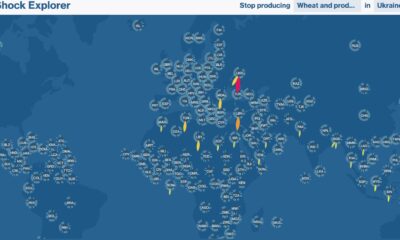Technology
Geologists find solid evidence of ancient ‘snowball Earth’

Our planet used to be a snowball. About 635 to 720 million years ago, the Earth was completely covered in thick ice. Although somewhat barren at the time, this period ultimately proved crucial for harboring complex life on Earth. Now an international team of scientists believe they have found the most complete geological record “snowball earth” in the Port Askaig Formation in Scotland and Ireland. This enormous rock group was probably deposited between 662 and 720 million years ago, just before a great boom in life. The findings are detailed in a study published on August 15 in the Journal of the Geological Society of London.
“These rocks record a time when the Earth was covered in ice,” study co-author and geologist at University College London, Graham Shields said in a statement. “All complex, multicellular life, such as animals, emerged from this deep freeze, with the first evidence appearing in the fossil record shortly after the planet thawed.”
[Related: ‘Dark’ archaeologists scour melting ice for ancient artifacts.]
Ice produces life?
The unique rocks in this study date back 60 million years Sturtian Ice Age. This is one of two major freezes during the Cryogenic period (between 635 and 720 million years ago). Billions of years before the Cryogenian, the planet was much warmer, but life on Earth consisted mainly of single-celled organisms and algae.
After this deep freeze, complex life probably began to emerge. Most animals alive today are similar in some fundamental respects to the life forms that evolved more than 500 million years ago. A prevailing theory Behind this explosion of life lies the fact that the extreme cold may have triggered the rise of altruism. Single-celled organisms somehow learned to work together to form multicellular life.
Both the advance and retreat of the ice across the Earth are thought to have occurred over thousands of years – relatively quickly in geological terms. The speed is likely due to the albedo effect, where the more ice there is, the more sunlight is reflected back into space and vice versa.
“The retreat of the ice would have been catastrophic. Life was used to tens of millions of years of deep freezes,” Shields said. “Once the world warmed, all of life would have had to compete in an arms race to adapt. What survived were the ancestors of all animals.”
[Related: First rocks recovered from Earth’s mantle.]
Yesterday’s ice leads to today’s rocks
To look for hard evidence of this period, the team looked at the Port Askaig Formation. This rock formation extends across present-day Ireland and Scotland and consists of several layers that are up to half a mile thick in some places.
One exposed outcrop on one group of Scottish islands called the Garvellachs contains geological evidence of our planet’s transition from warm and tropical to a frozen snowball during the Sturtian Ice Age. By comparison, other rocks that formed in North America and Africa at the same time do not show this climate transition.
“The rock layers exposed on the Garvellachs are unique in the world. Beneath the rocks formed during the unimaginable cold of the Sturtian Ice Age lie 70 meters deep [229 feet] of older carbonate rocks formed in tropical waters,” study co-author and UCL PhD candidate Elias Rugen said in a statement. “These layers reveal a tropical marine environment with thriving cyanobacterial life that gradually became cooler, marking the end of about a billion years of a temperate climate on Earth.”
The team collected sandstone samples from the Port Askaig Formation and from an older one, 70 meters thick Garbh Eileach formation below. They analyzed small durable minerals called zircons. These minerals are crucial for dating rocks – even on the moon – because they contain the radioactive element uranium. This element decays at a constant rate, so geologists can use this decay rate to get an idea of how old the rocks are. The zircons and other geochemical evidence suggest that the rocks here were deposited between 662 and 720 million years ago.
According to the team the new dating of the rocks could provide the evidence to officially declare this site as a marker for the beginning of the Cryogenic period in the geological record. Known as the Global Boundary Stratotype Section and Point (GSSP), some scientists call this mark a golden spike, because nails are sometimes driven into the rock to mark the boundary. The International Union of Geological Sciences is conducting a currency review on whether the Garvellachs foothills will have a gold peak.











